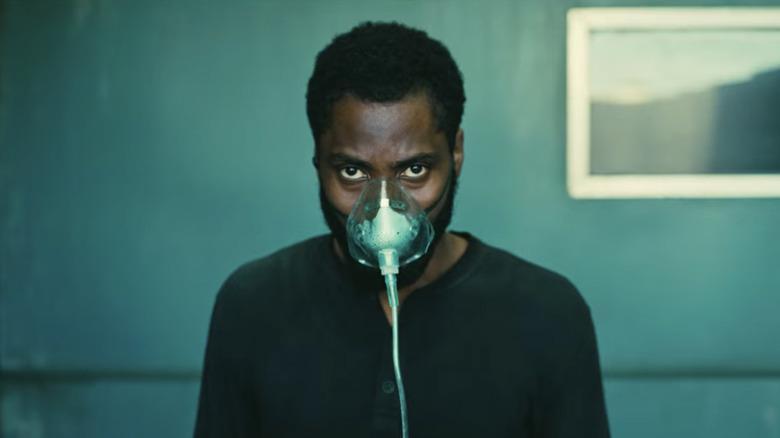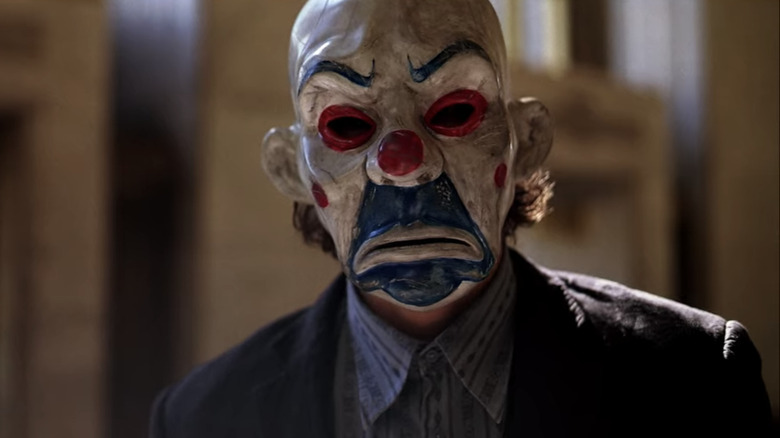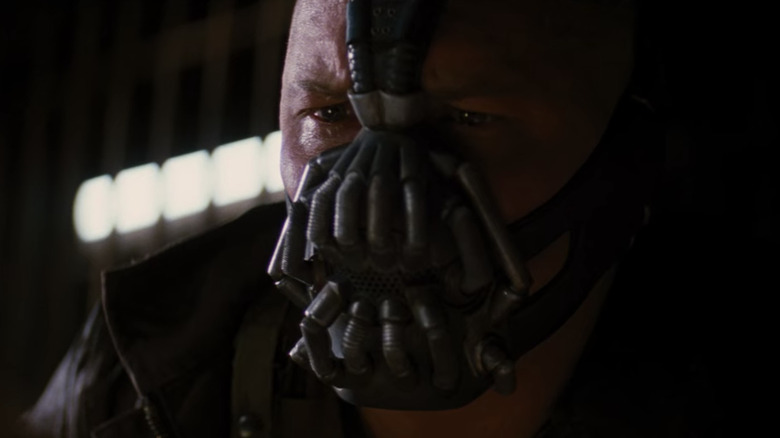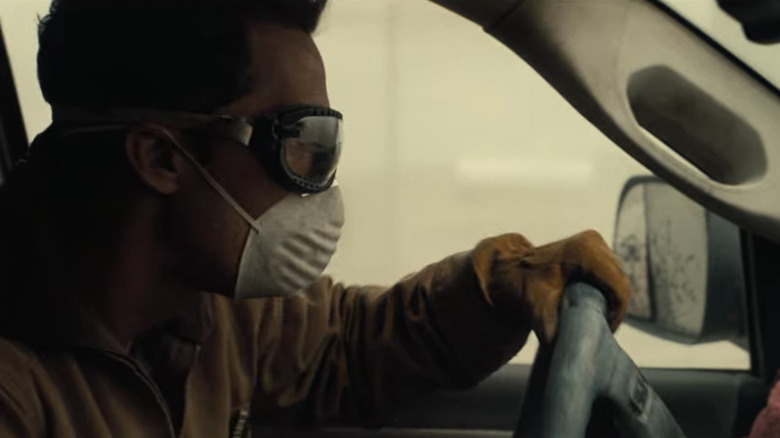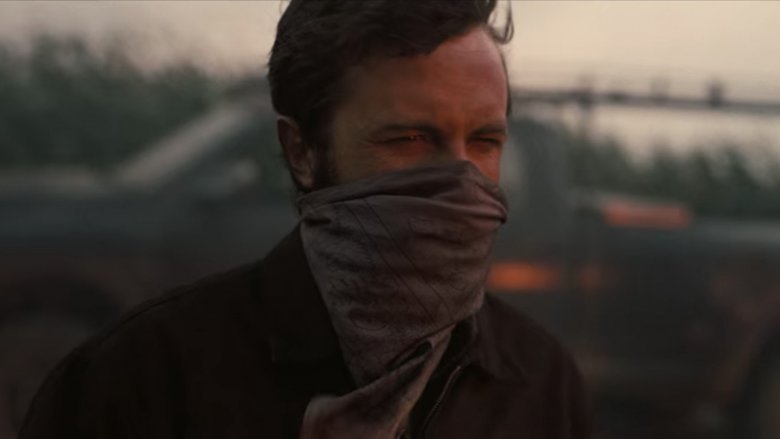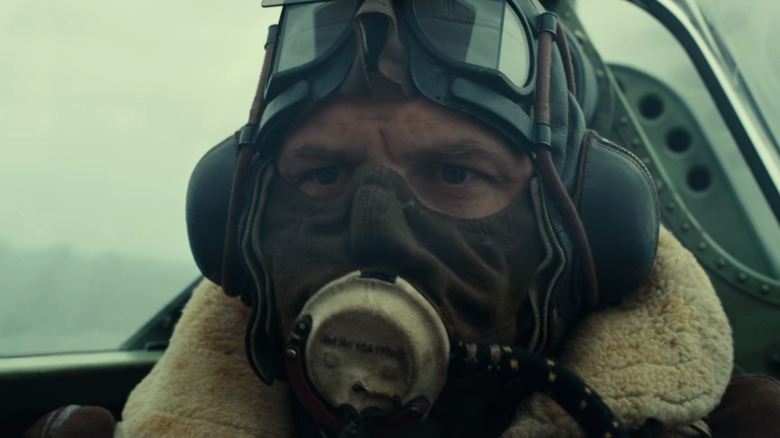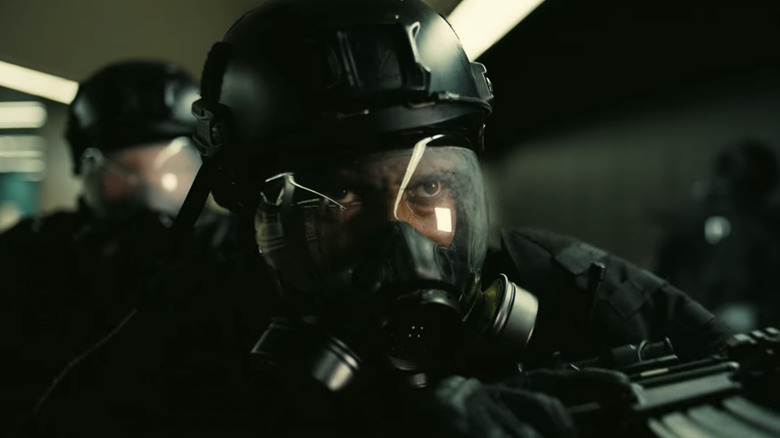Christopher Nolan's Filmography Predicted Our Current Masked, Muffled Reality
It's been a year now since Christopher Nolan's "Tenet," the movie that was supposed to bounce us back from the pandemic and save theaters, landed in the United States. For those who ventured out to see it, "Tenet" may have provided a surreal moviegoing experience — if only because the scene in the theater mirrored the one onscreen. In both of them, people had their faces covered in masks.
There are any number of movies or TV shows that could be said to have "predicted" aspects of the real-world future. In January 2020, just days after the first Covid cases on American soil were confirmed, we were already monitoring the sudden renewed iTunes popularity of Steven Soderbergh's "Contagion," a movie that anticipated the coronavirus outbreak.
Screenwriter Scott Z. Burns had consulted public health experts when penning the script, so if anything, it was science that predicted the future there, not some creative person "with a crystal ball," as he put it. Yet there are other cases. By sheer coincidence, if nothing else, movies like "Akira" and shows like "The Simpsons" have spitballed ideas about the future and inadvertently guessed right about what was coming.
What makes the case of Christopher Nolan so interesting is that something which might be regarded as predictive is a recurring motif in his filmography in the years leading up to the very thing it predicted. Back in 2011, around the time "Contagion" hit, a bug was working its way into Nolan's films, bringing masks and muffled sound to the forefront.
Nolan Pre-2011
We'll be focused mainly on the last decade of Nolan's films here, but just to be clear: the 2010s weren't necessarily the first time that complaints popped up regarding Nolan and sound. Masks are a normal feature of superhero films, including his own "Dark Knight" trilogy. He threw a sack over Cilian Murphy's face and had maggots crawling out of it in "Batman Begins." Is that a referendum on Mother Nature fighting back against us frail mortals? Probably not.
Yet the masked-and-muffled motif was there in the background even among the fanfare that accompanied "The Dark Knight" in 2008. I remember hearing a critic talk about the rooftop scene in "The Dark Knight," and how he couldn't always understand what Lt. Gordon (Gary Oldman) was saying. The camera circles around Gordon, Batman, and D.A. Harvey Dent (Aaron Eckhart) as they argue, and Gordon says, "Don't try to cloud the fact that clearly Maroni's got people in your office, Dent."
The only reason I can quote that line verbatim is because, even after watching "The Dark Knight" eight times in the theater, I myself had an issue deciphering the line until the movie finally hit home media and I could watch it with closed captions. I always just chalked it up to Oldman donning an American accent and not fully enunciating while delivering the line.
Like its sequel, however, "The Dark Knight" previewed its prologue in IMAX, and in that whole scene the Joker and his bank-robbing goons are running around, speaking through clown masks, their voices somewhat muffled.
The Dark Knight Rises
It was really in December 2011 when the first major chorus of complaints surfaced about the sound mix in a Nolan movie. The prologue for "The Dark Knight Rises" had begun showing in IMAX in front of "Mission: Impossible – Ghost Protocol," and reports circulated that moviegoers couldn't understand what the new villain, Bane, played by Tom Hardy, was saying. His dialogue, some said, was virtually inaudible through his mask.
Bane took things to a new level, sound-wise. Tom Hardy loves playing with voices, and Bane is undoubtedly his zaniest experiment to that end. In early 2012, it got to the point where Warner Bros. had to issue a denial that the studio or Nolan were tweaking the audio in "The Dark Knight Rises" to reduce background noise. Later that year, in Rolling Stone magazine, Nolan, referring to Hardy, enthused: "We've taken one of the most distinctive mouths in the movie business and covered it up!"
Bane's mask, which feeds him anesthesia, almost looks like a metallic version of one of the Facehuggers from "Alien." Ridley Scott's 1979 film is one of Nolan's favorites, so that's probably not a coincidence, but rather something that was baked into the design.
Real-life civilians who still don't want to wear face masks in public might not like the sensation of having a disposable or cloth Facehugger attached to their mouth ... but Bane's mask enabled him to live. Remember what happened to him after it got disconnected. He was left a groveling mess and soon got blown away by the Batpod.
Interstellar
Masks might not be the first image that comes to mind when you think of "Interstellar," but sure enough, they're there, as is the increasingly deafening use of Hans Zimmer's score and a wall of sound to drown out other audio and focus our eyes on visuals.
There comes a point in the movie where Matthew McConaughey's character, Coop, and his family, including his son, Tom (Timothée Chalamet), are driving through a dust storm. Coop has a line that begins with the word, "Alright," but instead of saying, "Alright, alright, alright," the way another McConaughey character might, he says, "Alright, gang, let's mask up."
He and his family promptly don white face masks. It won't be the last time we see Tom's mouth and nose covered. While revisiting "Interstellar" and its ending recently, I came away with a lot of extra screenshots, so permit me one bonus image in this section:
As you can see above, there's another scene later in the movie where an adult Tom, played by Casey Affleck, dons a scarf while his crops burn on an earth that's fast becoming uninhabitable. You have to wonder if he wasn't somehow receiving smoke signals from the 2020s.
"Interstellar" was predictive in other ways, like the scene where Coop sits down with his daughter's principal (David Oyewolo, the new Rocketeer) and has to litigate the moon landing with him and her teacher. The teacher thinks "the Apollo missions were faked to bankrupt the Soviet Union," and the school's textbooks have been corrected to reflect that. "Interstellar" came out in 2014, but in its own way, it hinted at the post-truth politics of the 2016 U.S. presidential election and the current wave of vaccine misinformation.
Dunkirk
Here comes Tom Hardy again, ready to act with his eyeballs and voice over a plane engine's roar. We met Bane in a plane and that's where Hardy's "Dunkirk" character feels most at home: in "The Air," as a super title informs us.
He's an RAF (Royal Air Force) pilot flying a Spitfire overhead during the Dunkirk evacuation in World War II. Technically, Farrier is his name. That's how the description and dialogue headings introduce him in Nolan's lean script, which was originally only 76 pages. (You can purchase a paperback or digital copy where books are sold.)
In the script, near as I can tell, Farrier is only referred to by name in dialogue twice, with the same line: "Come on, Farrier." The other three times he's referred to by the aviator callsign, Fortis 1, and two of those times, it's the disembodied voice of another pilot talking over the radio.
This feels close to our own disconnected, remote-work reality, where people communicate via online handles and we maybe only hear our colleagues in Slack huddles or see the eyes of store clerks over the top of their face masks.
At first, Farrier's mask is hanging off his face, so we get a rare glimpse of Hardy's clean-shaven mug, but anytime he needs to talk, he has to hold the mask up to his face: as usual, muffling his voice (which is less cartoonish than Bane's). Before long, he's masked up completely, per Coop's "Interstellar" marching orders.
Farrier is loosely inspired by a real flying ace, but one gets the impression that, at this point in his career, Nolan would almost rather not name his characters ...
Tenet
Enter: the Protagonist, John David Washington's character in "Tenet." At first, he's not only nameless; he's almost faceless. No sooner do we meet him than he's donning a mask.
"Tenet" opens in an opera house, but it might just as well be an IMAX theater. The orchestra tunes itself up, but, wait: bad guys in ski masks are now storming the opera house. Not to worry: good guys in gas masks and SWAT gear come running right in after them.
It's basically one big mask convention. The good guys dart into a side room and start talking, but the dialogue gets so garbled that you just know Nolan knows. He's doing it on purpose.
When "Tenet" hit U.S. theaters on September 3, 2020, it served as the surreal culmination of Nolan's masked-and-muffled movie fetish. Now, people were in theaters, wearing face masks, watching the Protagonist invert time in an oxygen mask. Once again, spoken words were difficult to make out, but this was no longer so strange because it paralleled our own pandemic situation.
"We live in a twilight world," the Protagonist insists. He's absolutely right. Look at the audience in that opera house, asleep to what is going on around them.
In "Inception," Nolan explored the concept of shared dreams, and in the four films that followed, it's as if he tapped into something in the collective unconscious: a foreknowledge of the fate that awaited human society this decade. Times are tough, obviously, but the next time you "mask up" — and perhaps strain to hear what someone else is saying in their mask — just remember, you're now living in a Christopher Nolan movie.
